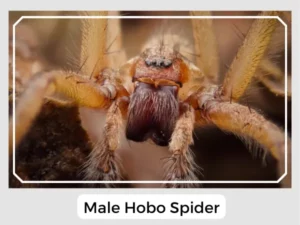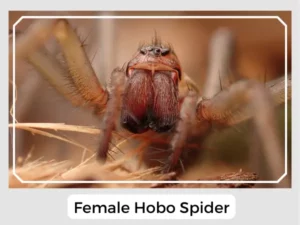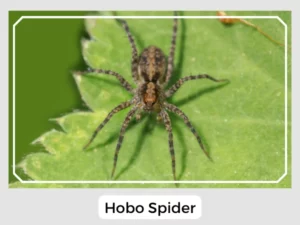The Hobo spider is different from the Australian funnel-web, even though they both belong to the funnel-web spider group. With various scientific names like Philoica agrestis and Tegenaria rhaetica, these spiders can be found in Europe, Central Asia, and North America. Here, you’ll discover more interesting facts about them!
The female hobo spider lays eggs during September that go on to hatch the following spring. The mother produces about four sacs in her lifetime containing 100 eggs each, which she attaches to the bottom of an object or the surface nearby.
Juvenile spiders emerge around June, and they go through several molting phases before reaching adulthood. It takes around one or two months to attain complete maturity.
They build trampoline-shaped horizontal webs close to woodpiles, and brick walls, where the spider shelters, waiting for its prey to arrive.
Yes, Hobo spiders are venomous. However, their venom is not considered highly toxic to humans. Earlier theories suggest that necrosis or skin death could be an effect of the hobo spider bite, but the 2017 reports refute this fact and do not include this species under the list of most venomous spiders.
Yes, Hobo spiders can bite. While they aren’t typically aggressive, they might bite if they feel threatened or cornered. Their bite goes unnoticed initially, but in 15 minutes, the victim could sense numbness and pain in the affected area. It may eventually turn red, harden, and become swollen. In the case of severity, the area could turn black after a fluid discharge. However, no fatality has been recorded.

Photo Credit: Kyron Basu

Photo Credit: Kyron Basu
Hobo spiders are integral to their ecosystems. They help control insect populations, as they primarily feed on small insects caught in their funnel-shaped webs. These webs are strategically constructed close to ground level in dark and moist areas, such as woodpiles and brick walls. By preying on insects, they maintain a balance within their habitat, indirectly supporting plant life and soil health.
Natural Predator: These spiders face threats from larger predators, notably other bigger spiders and ants. These natural checks and balances contribute to the predator-prey dynamics that Hobo spiders are part of, ensuring no single species dominates the ecological niche.
Prey-Predator Dynamics: In the wild, the Hobo spider is both a predator and prey, which places it firmly within the intricate food web. Their diet consists mainly of insects, which they capture with precision in their webs. The survival strategies of Hobo spiders, from the design of their webs to their swift hunting techniques, highlight their role as effective predators.
Relationship with Humans: Although Hobo spiders are venomous, their bites are not fatal to humans. Misunderstandings have arisen from their resemblance to more dangerous spiders, such as the brown recluse. However, they generally avoid human contact and only bite when they feel threatened.
| Distribution | North America, Central Asia, and Europe |
| Habitat | Fields, crevices, basements, moist and dark areas |
| Diet | Insects and other spiders |
| Web-type | Funnel-shaped |
| Predators | Other bigger spiders and ants |
| IUCN Conservation Status | Not listed |
In summary, by understanding the Hobo spider’s behavior, we gain a deeper appreciation for these often-misunderstood creatures and their place in our world.

The Hobo spider is different from the Australian funnel-web, even though they both belong to the funnel-web spider group. With various scientific names like Philoica agrestis and Tegenaria rhaetica, these spiders can be found in Europe, Central Asia, and North America. Here, you’ll discover more interesting facts about them!
The female hobo spider lays eggs during September that go on to hatch the following spring. The mother produces about four sacs in her lifetime containing 100 eggs each, which she attaches to the bottom of an object or the surface nearby.
Juvenile spiders emerge around June, and they go through several molting phases before reaching adulthood. It takes around one or two months to attain complete maturity.
They build trampoline-shaped horizontal webs close to woodpiles, and brick walls, where the spider shelters, waiting for its prey to arrive.
Yes, Hobo spiders are venomous. However, their venom is not considered highly toxic to humans. Earlier theories suggest that necrosis or skin death could be an effect of the hobo spider bite, but the 2017 reports refute this fact and do not include this species under the list of most venomous spiders.
Yes, Hobo spiders can bite. While they aren’t typically aggressive, they might bite if they feel threatened or cornered. Their bite goes unnoticed initially, but in 15 minutes, the victim could sense numbness and pain in the affected area. It may eventually turn red, harden, and become swollen. In the case of severity, the area could turn black after a fluid discharge. However, no fatality has been recorded.

Photo Credit: Kyron Basu

Photo Credit: Kyron Basu
Hobo spiders are integral to their ecosystems. They help control insect populations, as they primarily feed on small insects caught in their funnel-shaped webs. These webs are strategically constructed close to ground level in dark and moist areas, such as woodpiles and brick walls. By preying on insects, they maintain a balance within their habitat, indirectly supporting plant life and soil health.
Natural Predator: These spiders face threats from larger predators, notably other bigger spiders and ants. These natural checks and balances contribute to the predator-prey dynamics that Hobo spiders are part of, ensuring no single species dominates the ecological niche.
Prey-Predator Dynamics: In the wild, the Hobo spider is both a predator and prey, which places it firmly within the intricate food web. Their diet consists mainly of insects, which they capture with precision in their webs. The survival strategies of Hobo spiders, from the design of their webs to their swift hunting techniques, highlight their role as effective predators.
Relationship with Humans: Although Hobo spiders are venomous, their bites are not fatal to humans. Misunderstandings have arisen from their resemblance to more dangerous spiders, such as the brown recluse. However, they generally avoid human contact and only bite when they feel threatened.
| Distribution | North America, Central Asia, and Europe |
| Habitat | Fields, crevices, basements, moist and dark areas |
| Diet | Insects and other spiders |
| Web-type | Funnel-shaped |
| Predators | Other bigger spiders and ants |
| IUCN Conservation Status | Not listed |
In summary, by understanding the Hobo spider’s behavior, we gain a deeper appreciation for these often-misunderstood creatures and their place in our world.
